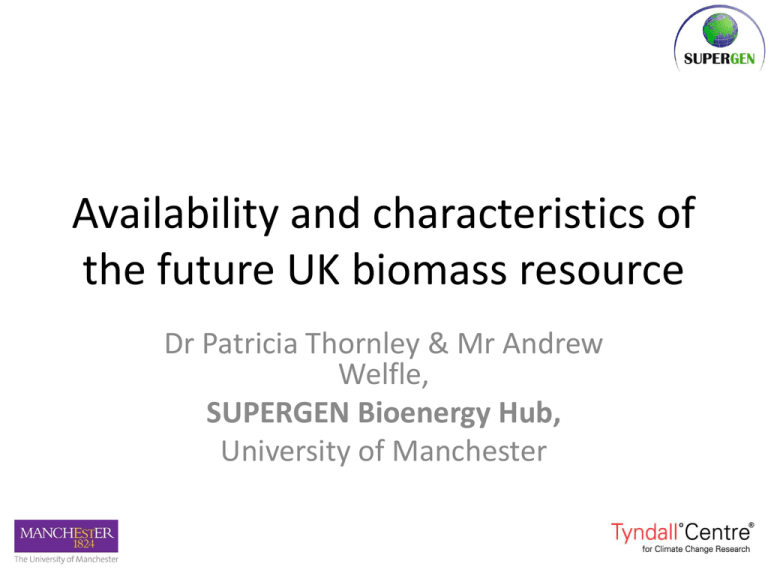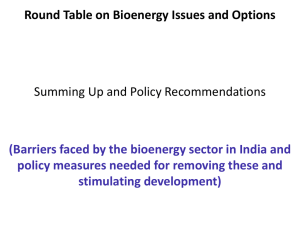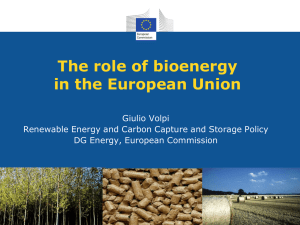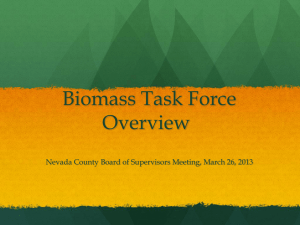Availability and characteristics of the future UK biomass resource
advertisement

Availability and characteristics of
the future UK biomass resource
Dr Patricia Thornley & Mr Andrew
Welfle,
SUPERGEN Bioenergy Hub,
University of Manchester
Presentation overview
1. Background to the SUPERGEN Bioenergy Hub
2. Context for future UK biomass resource
3. Specifics of future UK biomass resource
Hub Objectives
– Act as a focal point for sharing and
dissemination of scientific knowledge and
engineering understanding to facilitate nearterm deployment of technologies
– Investigate and develop new approaches for dealing with
the very significant engineering challenges associated
with deployment of more novel technologies
– Improve scientific understanding of the fundamental
aspects of different forms of biomass and its conversion
– Take a whole-systems perspective to comprehensively
evaluate the potential of future technology options
– Adopt an interdisciplinary approach to look beyond the
engineering and technical aspects of bioenergy and
ensure adequate consideration of the impacts on
ecosystems, social responses to technology deployment
and the economic context of policy development
SUPERGEN Bioenergy Hub
Tyndall Manchester
Aston University
University of Bath
Leeds University
Newcastle University
Rothamsted Research
Drax
Progressive Energy
Renewable Energy Association
North Energy Associates
Sustainable Energy Ltd
Renewable Energy Systems
Greenacres
Biomass Energy Centre
Danish Tecnologik Instituit
Dalkia
Projects
Initial projects
1. Emissions from solid biomass
2. Impact of feedstock parameters on
airborne emissions
3. Evaluation of substitute natural gas
4. Streamlining the supply chain
5. Carbon uncertainties in the supply chain
6. Gasification integration
7. Torrefaction integrated assessment
8. Carbon capture & storage enabling
technologies
9. Bio-oil upgrading
10. Whole systems analysis of novel biofuel
technologies
Later work
1. Public perceptions
2. Biochar
3. Biomass for carbon/materials
4. Micro algae
5. Sustainability of imports
6. Food-fuel conflict
7. Gasification demo plant
etc.
2. Context for future UK
biomass resource
Availability and characteristics of
future UK biomass resource
The biomass resource from UK feedstocks could
reach around 10% of current UK primary energy
demand by 2030, at a cost of less than £5/GJ 1
Plus a large global woody biomass element
Supergen Bioenergy research shows that the
sustainable level of UK biomass resource is lower
than this: 4.9% of total energy demand (4.3% of
heat demands, 4.3% of electricity, and 5.8% of
transport fuel). 2
Plus a large global woody biomass element
(1) DECC, 2009, ‘Biomass Supply Curves for the UK’, www.decc.gov.uk/publications/
(2) Thornley et al., “Sustainability constraints on UK bioenergy development”, Energy Policy, 2009
Future feedstocks (1)
Making efficient use of available waste often
maximizes sustainability benefits, particularly
greenhouse gas balances
Greenhouse gas savings
GHG
emissions
(kg
CO2e/MWh)
Savings
Savings
Savings
compared to compared to compared to
UK grid
CCGT plant EU fossil
fuel mix
Forest
residues
58
90%
86%
92%
Recycled
wood
-740
226%
280%
204%
Eucalyptus
149
75%
64%
79%
Thornley et al., “Assessing the sustainability of bioelectricity supply chains”, BIOTEN
conference, Birmingham
Future feedstocks (2)
Feedstock characteristics significantly impact on
plant performance
Uniform feedstocks are particularly attractive
Technologies that are “omnivorous”/feedstock
flexible are key to unlocking significant
resources
Thornley, P., “Biofuels Review”, Report for Government Office for Science, prepared as part
of the Foresight Programme, June 2012
Future feedstocks (3)
Second generation technologies help address
many sustainability issues because of their
“whole-chain” (not their thermodynamic!)
efficiency
Greenhouse gas savings are not dependent on
efficiency
Thornley et al., “Integrated assessment of bioelectricity technology options”, Energy
Policy 37 (2009), 890-903
Importance of advanced technologies
First generation
Land area
Biomass
Convertible
portion of
biomass
Conversion
product
Final fuel
product
Second generation
Thornley, P., “Biofuels Review”, Report for Government Office for Science, prepared as part
of the Foresight Programme, June 2012
3. Specifics of future UK
biomass resource
Modelling Approach
Stage One –
Assessment of the UK
Land Area Available for
Biomass Resource
Growth
Stage Two – Biomass
Planting Scenarios &
Quantifying the
Indigenous Biomass
Resource
Stage Three – The
Bioenergy Resource
Demand: Balancing
Indigenous Potential vs.
Imports
Developing Resource Forecast Scenarios
Food Focus
Prime aim of enhancing
food security and
increasing self
sufficiency.
- Increased crop yield productivity rates.
- Decreased food waste rates.
- Balanced waste management forecast.
- Reduced land for bioenergy crop growth.
Economic
Focus
Emphasis placed on
economic development
over other
considerations.
- Increased rate of built-up area expansion.
- Increased food & forest/wood product exports.
- Focus on forestry expansion/productivity
- Increased utilisation of forestry residues.
Conservative
Focus
Future pathway with
increased emphasis on
conservation and
resource protection.
- Reduced expansion of built-up land area.
- High focus on forestry expansion & preservation.
-Reduced rates of waste generation
- Waste management focusing on resource recovery.
- Increased focus on forestry expansion/productivity
Energy
Focus
Focus on enhancing and
-High utilisation of biomass wastes and residues.
expanding the bioenergy
-Waste management focusing on energy recovery.
sector.
-Increased land availability for bioenergy crops.
Potential Resource Availability within each Scenario
Energy Crops, Forestry
Product, SRF, SRC etc
150,000
100,000
50,000
0
Base
2015
2020
2030
2050
Agricultural, forestry,
industry etc
Economic Focus Scenario
200,000
Waste Biomass
Resource
150,000
100,000
50,000
0
Base
Residue Biomass
Resource
2015
2020
2030
2050
MSW,
Sewage/Sludges,
Industry etc
Tonnes Resource ('000 ODT
eqv.)
Tonnes Resource ('000 ODT
eqv.)
Tonnes Resource ('000 ODT
eqv.)
200,000
Food Focus Scenario
200,000
150,000
100,000
50,000
0
Base
2015
2020
2030
2050
Conservation Focus Scenario
Tonnes Resource ('000 ODT
eqv.)
Grown Biomass
Resource
Energy Focus Scenario
200,000
150,000
100,000
50,000
0
Base
2015
2020
2030
2050
Conclusions
– Waste resources will be even more significant
in future
– Integration of bioenergy with the global food
system is important
– Imports are essential for UK targets and
flexible technologies are needed to be resilient
to their characteristics
– Second generation technologies improve
many “sustainability” issues because of their
higher efficienty potential
– The interfaces between the food system, land
system, energy system and biomaterials
demands must be taken into account in
bioenergy resource assessments
Availability and characteristics of
the future UK biomass resource
Dr Patricia Thornley & Mr Andrew
Welfle,
SUPERGEN Bioenergy Hub,
University of Manchester







